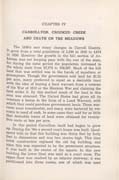
[p. 37]
CHAPTER IV
CARROLLTON, CROOKED CREEK AND DEATH ON THE MEADOWS
The 1840's saw many changes in Carroll County. It grew from a total population of 2,844 in 1840 to 4,614 in 1850. However the growth in the hill section of Arkansas was not keeping pace with the rest of the state, for during the same period the population increased in the whole state from 97,574 to 209,897. Much of the hill land that was settled was in the hands of squatters or preemptors. Though the government sold land for $1.25 Per acre, many preferred to squat on a desirable tract with the idea of buying a land warrant from a veteran of the War of 1812 or the Mexican War and claiming the land under it. By this method much of the land in this area was obtained. The United States had given all its veterans a bonus in the form of a Land Warrant, with which they could purchase government lands. These warrants were transferable, and many were bartered by veterans in need of cash. In some cases they sold for so little that desirable tracts of land were obtained for twenty-five cents or less per acre.
In this period Carrollton itself had begun to grow up. During the '40s a second court house was built. Goodspeed tells us that this building was thirty feet by forty feet in dimensions and was two stories high. This time brick construction replaced the old log building, and since this was expected to be the permanent structure, it was built in the center of the square. In this new building the lower floor was used as a court room. The upper floor was reached by an interior stairway; it was partitioned into three rooms, one of which was used
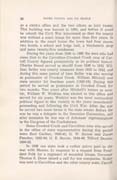
[p. 38]
as a clerk's office and the two others as jury rooms. This building was burned in 1860, and before it could be rebuilt the Civil War intervened so that the county was without a court house for more than five years. In addition to the court house the town had four stores, two hotels, a school and lodge hall, a blacksmith shop and some twenty-five residences.
During the years from 1840 to 1860 the men who had come first to the Carrollton-Crooked Creek area of Carroll County figured prominently in its political history. Charles Sneed served as sheriff from 1836 to 1842. William Beller was county treasurer from 1838 to 1842, and during this same period of time Beller was also serving as postmaster of Crooked Creek. William Mitchell was state senator for fourteen years (1840-54). During this period he served as postmaster at Crooked Creek for two months. Two years after Mitchell's tenure as senator, William W. Watkins was elected to this office and served for six years. Watkins was the most outstanding political figure in this vicinity in the years immediately preceeding and following the Civil War. After the war he served two more terms in the state senate. Before the war he was a delegate to the Secession Convention, and after secession he was one of Arkansas' representatives to the Congress of the Confederacy.
Some Crooked Creek and Carrollton men who served in the office of state representative during this period were Beal Gaither, 1840-42; G. W. Baines and James Fancher, 1842-44; G. E. Bernie, 1844-46; Tilford Denton, 1850-52.
In 1846 our state took a rather active part in the war with Mexico. In response to a request from President Polk for a regiment of mounted troops, Governor Thomas S. Drew issued a call for ten companies. Notice was sent to Carrollton and the other county seats. Carroll
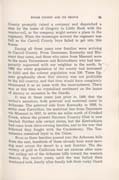
[p. 39]
County promptly raised a company and dispatched a man by the name of Gregory to Little Rock with the muster-roll, so the company might secure a place in the regiment. When the messenger arrived the regiment was full so the Carroll County boys failed to get into this fracas.
During all these years new families were arriving in Carroll County. From Tennessee, Kentucky and Missouri they came, and those who came from Missouri were in the main Tennesseans and Kentuckians who had temporarily sojourned with our neighbor to the north. In 1860 the white population of the county had increased to 9,053 and the colored population was 330. These figures graphically show that slavery was not profitable in the hill country, and that time would have completely eliminated it as an issue with the mountaineers. There was at this time no crystalized sentiment on the issues of slavery or secession in the Ozarks.
It was in these years just prior to 1860 that the writer's ancestors, both paternal and maternal came to Arkansas. The paternal side from Kentucky in 1858, to settle near Carrollton; the maternal line from Tennessee via Missouri in 1857, to settle six miles north of Crooked Creek, where the present Harrison Country Club is now located. Neither side owned slaves, but the Kentuckians had come from slave-owning families, and in the war that followed they fought with the Confederacy. The Tennesseans remained loyal to the Union.
Even as these families poured into the Arkansas hills from the east, hundreds of those already here were moving west across the desert to a new frontier. The discovery of gold in California had set caravan after caravan rolling out of the Arkansas hills toward the western deserts. For twelve years, until the war halted their Westward trek, family after family left their rocky Ozark
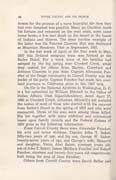
[p. 40]
homes for the promise of a more bountiful life than they had ever dreamed was possible. Many an Ozarkian made his fortune and remained on the west coast; some came home broke; a few met death on the desert at the hands of Indians and thieves. The most terrible example of the latter was the Fancher Caravan that was destroyed at Mountain Meadows, Utah in September, 1857.
In the last week of April or the first week in May, 1857 this ill-fated emigrant train was formed at the Beller Stand. For a week some of the families had camped by the big spring near Crooked Creek, while they waited for others from Marion, Crawford and Johnson Counties to join them. Captain Alexander Fancher of the Osage community in Carroll County was the leader of the party. Captain Fancher had made two overland journeys to California prior to this 1857 trek.
On file in the National Archives in Washington, D. C. is a list submitted by William Mitchell to the Office of Indian Affairs, Utah Superintendency, dated April 27, 1860 at Crooked Creek, Arkansas. Mitchell's list contains the names of most of those who started with the caravan from Beller's Stand in the spring of 1857 and who were massacred. Three of his sons were among those killed. His list together with some additions and corrections based upon family records and the Federal Census of 1850 gives us the following information:
From Carroll County there were Alexander Fancher, his wife and seven children; Captain John T. Baker, fifty-two years of age, and his son, George W. Baker, twenty-seven years of age, and George's wife, Manerva and daughter, Vinia; Abel Baker, nineteen years old, son of John T. Baker; James Matthew Fancher and Robert Fancher, nineteen and twenty-five years old respectively, both being the sons of Jane Fancher.
Others from Carroll County were David Beller and
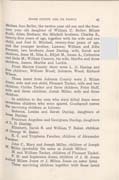
[p. 41]
Melissa Ann Beller, the twelve year old son and the fourteen year old daughter of William C. Beller; Milum Rush; Allen Deshazo; the Mitchell brothers, Charles R., twenty-five years of age, together with his wife and one child, and Joel D. Mitchell, twenty-four years of age, and the younger brother, Lawson; William and John Prewett, two brothers; Jesse Dunlap, wife, Sarah and children, Jesse M., Ibba A., Elijah M., Susan A., Catherine and Beda M.; William Camron, his wife, Martha and three children, James, Martha and Larkin.
From Marion County there were L. D. Dunlap and five children; William Wood; Solomon Wood; Richard Wilson.
Those listed from Johnson County were J. Milam Jones, wife and one child; Pleasant Tacket, wife and two children; Cintha Tacket and three children; Peter Huff, Wife and three children; Josiah Miller, wife and three children.
In addition to the ones who were killed there were seventeen children who were spared. Goodspeed names the surviving children as follows:
Rebecca, Louisa and Sarah Dunlap, daughters of Jesse Dunlap.
Prudence Angeline and Georgiana Dunlap, daughters of L. D. Dunlap.
Elizabeth, Sarah R. and William T. Baker, children of George W. Baker.
K. C. and Tryphena Fancher, children of Alexander Fancher.
John C., Mary and Joseph Miller, children of Joseph M. Miller (probably the same as Josiah Miller).
M. and William Tacket, children of Pleasant Tacket. F. M. and Sophronia Jones, children of J. M. Jones (called Milam Jones or J. Milam Jones on some lists).
These surviving children together with those listed
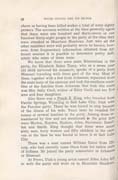
[p. 42]
above as having been killed makes a total of some eighty persons. The accounts written at the time generally agree that there were one hundred and thirty-seven or one hundred thirty-eight people in the party at the time they were attacked at Mountain Meadows. Just who all the other members were will probably never be known; however, from fragmentary information obtained from different sources it is possible to determine pretty definitely who some of them were.
We know that there were some Missourians in the party, for Elizabeth Baker Terry, who as a seven year old child survived the massacre, speaks of a party from Missouri traveling with them part of the way. Most of these, together with a few from Arkansas, separated from the main body of the caravan and took the southern route. One of the families from Arkansas that took this route was Mrs. Sally Cecil, widow of Riley Cecil, and her five sons and four daughters.
Also there was a Frank E. King, who traveled from Pacific Springs, Wyoming to Salt Lake City, Utah with the Fancher party. There he was forced to stop because of the illness of his wife. Years later he recalled the names of several families in the party. Among those remembered by him and not mentioned in the prior lists were Morton, Haydon, Hudson, Aden, Stevenson, Hamilton and Smith. King thought that there were about sixty men, forty women and fifty children in the caravan at the time he was forced to leave it at Salt Lake City.
There was a man named William Eaton from Illinois, who had recently come there from his native state of Indiana. He joined the party somewhere in Arkansas or Missouri.
At Provo, Utah a young artist named Allen Aden fell in with the party and went on to Mountain Meadows.
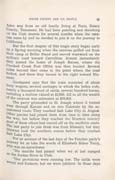
[p. 45]
Aden was from an old family living at Paris, Henry County, Tennessee. He had been painting and sketching on the Utah deserts for several months when the caravan came by and he decided to join it on the journey to California.
But the first chapter of this tragic story began early en a Spring morning when the caravan pulled out from their camp at Beller Stand and moved westward on the military road toward Carrollton. Almost immediately they passed the home of Joseph Baines, where the Crooked Creek Post Office was then located. Several miles beyond they came to the point where the road forked, and there they turned to the right toward Missouri.
Goodspeed says that the train consisted of about forty wagons, several carriages in which the ladies rode, nearly a thousand head of cattle, several hundred horses, including a stallion valued at $2,000. All in all the wealth of the caravan was estimated at $70,000.
The party proceeded to St. Joseph where it turned west through Kansas and on into Colorado by the accustomed route. They reached Salt Lake City in August. Other parties had joined them from time to time along the way, but before they reached the Mormon country most of these others had veered off on the southern route. The last party to join them was from Missouri, but they likewise took the southern course before they reached Salt Lake City.
For an account of the last days of the Fancher party's journey let us take the words of Elizabeth Baker Terry, who was an eyewitness:
"Six months had passed when we at last camped on the Jordan River in Utah.
"Our provisions were running low. The cattle were weary and footsore, but we were jubilant. In those days
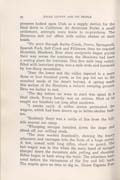
[p. 44]
pioneers looked upon Utah as a supply station for the final drive to California. At American Forks, a small settlement, attempts were made to re-provision. The Mormons met our offers with sullen shakes of their heads.
"We went through Battle Creek, Provo, Springwell, Spanish Fork, Salt Creek and Fillimore, then we reached Mountain Meadows. Ever since emigrants began plying their way across the continent, the Meadows had been a resting place for travelers. This five mile long valley, filled with luxuriant grass, was a mile wide and bordered by low-flung mountains.
"Near the lower end the valley tapered to a mere three or four hundred yards, as the gap led out to the scorched sands of the desert beyond. A spring made this section of the Meadows a natural camping ground. Here we halted to rest.
"The day before we were to start was spent in a final check. Every family was on rations. Most of us sought our blankets not long after sundown.
"I awoke early. A coffee aroma permeated the wagons, which had been drawn up in helter-skelter fashion.
"Suddenly there was a rattle of fire from the hillside nearest our camp.
"Whooping savages tumbled down the slope and sliced off our milling stock.
"The men worked frantically, shoving the heavy schooners and carriages into the form of a huge corral. A few, armed with long rifles, stood on guard. The last wagon was in line when the main band of savages charged down the mountain side, yelling and shooting. Rifles began to bark along the train. The attackers hesitated before the viciousness of the fire and fell back. The respite gave us time to dig in. Under Captain Fan-
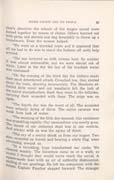
[p. 45]
cher's direction the wheels of the wagon corral were locked together by means of chains. Others hurried out with picks and shovels and dug feverishly to throw up a breastwork. Even the women helped.
"We were on a traveled route and it appeared that all we had to do was to stand the Indians off until help arrived.
"The sun tortured us with intense heat. By midday it was almost unbearable, and we were almost out of water. Later in the day the last of the brackish water was consumed.
"On the evening of the third day the Indians made their most determined attack. Crouched low, they circled about the train, shooting inaccurately. The Meadows afforded little cover and our assailants felt the lash of the corral sharpshooters. Back they went to the hillsides, carrying their wounded with them. The seige was on again.
"The fourth day was the worst of all. The wounded were actually dying of thirst. The entire caravan was weak from lack of water.
"The morning of the fifth day dawned. Our resistance was crumbling rapidly. Our ammunition was nearly gone. The stench of our unburied dead was in our nostrils. And always with us was the agony of thirst.
"The cry of a sentry shook us from our stupor. Two men, mounted on horses and bearing a white flag, were advancing toward us.
"In a twinkling, hope transformed our ranks. We cheered weakly. The horsemen came on at a walk, so slowly I thought they would never reach the corral. A square-made man with an air of authority dismounted, smiling at our greetings. He left his companion with the horses, Captain Fancher stepped forward. The stranger
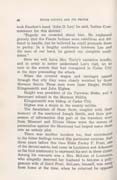
[p. 46]
took Fancher's hand. 'John D. Lee,' he said, 'Indian Commissioner for this district.'
"Eagerly we crowded about him. He explained gravely that the Piaute Indians were rebellious and difficult to handle, but he believed he could persuade them to parley. In a lengthy conference between Lee and the men of our band, he gained our complete confidence."
Here we will leave Mrs. Terry's narrative briefly, and in order to better understand Lee's visit, let us turn to the events that had transpired in Cedar City in the days preceeding the attack.
When the covered wagon and carriages passed through that city they were closely watched by three Mormon Saints. These men were Isaac Haight, Philip Klingensmith and John Higbee.
Haight was president of the Parowan Stake, and a lieutenant colonel in the Mormon Militia.
Klingensmith was bishop of Cedar City.
Higbee was a major in the county militia.
The fanaticism of these three, coupled with their memory of the martyred Joseph Smith, and their possession of information that part of the travelers were from Missouri and Illinois (these were the scenes of persecution against the Mormons) had helped move them into an unholy plot.
There was another incident too, that contributed to the bitter feelings toward this particular caravan. Just three years before this time Elder Parley P. Pratt, one of the devout saints, had come to Louisiana and Arkansas as the first missionary to represent his sect in these states. Among his converts was a Mrs. McLean of Louisiana, who allegedly deserted her husband to become a polygamous wife of Saint Pratt. McLean, himself, was away from home at the time, when he returned he opposed
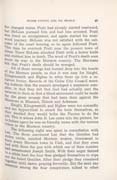
[p. 47]
the changed status. Pratt had already started westward, but McLean pursued him and had him arrested. Pratt was freed on arraignment, and again started his westward journey. McLean was not satisfied with the outcome of the court hearing, so he again followed Pratt. This time he overtook Pratt near the present town of Alma. There McLean attacked Pratt with a bowie knife and stabbed him to death. The word of Pratt's death soon Made its way to the Mormon country. The Mormons felt that Pratt's death should be avenged.
All of these wrongs had burned deep into the hearts of the Mormon people, so that it was easy for Haight, Klingensmith and Higbee to whip them up into a religious frenzy. Records of the Cedar City Council meeting indicate that the council developed a messianic complex, in that they felt that God had actually sent the caravan to them so that a blood atonement could be made for the great wrongs that had been done against the Mormons in Missouri, Illinois and Arkansas.
Haight, Klingensmith and Higbee were too cowardly they too hypocritical to attack the train themselves, so they decided they would bribe the Piautes to do the job. This is where John D. Lee came into the picture, for as Indian agent he was on friendly terms with the various tribes in the Mormon country.
The following night was spent in consultation with Lee. The three convinced Lee that the Gentiles had stolen cattle, insulted Mormon women, threatened to burn every Mormon town in Utah, and that they even had with them the gun with which one of their number had assassinated Joseph Smith. With their anger fanned to a white heat the four then pledged themselves to wipe out together the hated Gentiles. After their pledge they remained together until dawn, praying fervently. But the next day someone among the four conspirators talked to other

[p. 48]
Mormons, and the more sober heads in Cedar City made plans to head off the vicious plot. There was no one to whom they could appeal locally, so they decided to go to the highest recognized authority. They dispatched a messenger to Brigham Young to ask his decision. The messenger reached President Young on September 10, 1857. It is pretty conclusively established that Young sent the messenger back immediately with the command to give the emigrants safe passage through the Mormon country. The messenger did not arrive until after the seige had begun, and as a matter of fact, it had almost failed because the Indians had met such stubborn resistance that they were ready to call the whole thing off.
Haight received Brigham Young's message, but the beseiged caravan already knew too much, so there could be no backing up. He deliberately lied to Higbee, who in turn passed the erroneous order to Lee. The order Lee received read: "Kill everyone old enough to talk."
Several of the Indians had already gone back to their homes, so Lee and Higbee recruited some forty fanatical Saints to help them write the last chapter to this sordid tale.
This brings us up to date with the Mormon phase of our story, for it was at this point that John D. Lee rode up under a flag of truce, dismounted from his horse and taking Alexander Fancher by the hand, offered his services to help the caravan in their hour of dire need.
Let us now turn back to Mrs. Terry's account of the last gruesome details of this dark picture.
"When the Indian Commissioner rode off our hopes and prayers went with him. He was gone two hours.
"He came back at a gallop, a wagon following his dust. He said, 'They've agreed to let you go if you surrender your arms.'
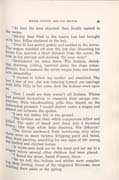
[p. 49]
"At first the men objected, then finally agreed to the terms.
"Slowly they filed to the wagon Lee had brought with him. Rifles clattered in the bed.
"John D. Lee smiled grimly and nodded to the driver. The wagon rumbled off over the low rise. Mounting his horse, Lee spurred a short distance from the corral. He rose in his stirrups and shouted, 'Do your duty!'
"Bewildered we stood there. The Indians, shrieking, shooting, yelling, tumbled down the slope triumphantly. For a moment the entire wagon train was frozen into immobility.
"I started to follow my mother and stumbled. The last I saw of her, she was running toward our carriage with little Billy in her arms. And the Indians were upon us.
"Now I could see they weren't all Indians. Whites had painted themselves to resemble their savage companions. With bloodcurdling yells they leaped on the defenseless pioneers. I sought shelter under a wagon and peered out between the spokes.
"I saw my father fall to the ground.
"The Indians and their white companions killed and killed. The sight of blood sent them into a fanatical frenzy. One huge white kept shouting, 'For Jehovah!'
"The fiends slackened their butchering only when there were no more victims. Dripping paint and blood, they stood panting, searching for any signs of life among the hacked and clubbed bodies.
"A white man took me by the hand and led me to a wagon where several other children had been placed.
"I found my sister, Sarah Frances, there.
"As we left, the Indians and whites were completing their looting. Some of the disguised Mormons were washing their paint at the spring.
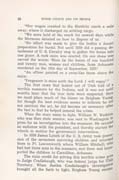
[p. 50]
"Our wagon creaked to the Hamblin ranch a mile away, where it discharged its sobbing cargo.
"We were held at the ranch for several days while the Mormons debated on how to dispose of us.
"No effort was made to give the bodies a decent preparation for burial. Not until 1859 did a passing detachment of U. S. Cavalry stop to gather the bones into one grave. A rock cairn was erected. On one stone was carved the words: 'Here lie the bones of one hundred and twenty men, women and children, from Arkansas, murdered on the 10th day of September, 1857.'
"An officer painted on a cross-like beam above the cairn:
'Vengeance is mine saith the Lord. I will repay'."
The first news that leaked out of Utah told of a terrible massacre by the Indians, and it was not until months later that the true facts were suspected. Here we must place much of the blame on Brigham Young, for though the best evidence seems to indicate he did not sanction the act, he did become an accessory after the fact in that he helped conceal the crime.
When the story came to light, William W. Watkins, who was then state senator, was sent to Washington to press for an investigation into the massacre. He secured an audience with the president, and thereby started the wheels in motion for government intervention.
In 1859 James Lynch of the U. S. Army took possession of the seventeen surviving children and returned them to Ft. Leavenworth where William Mitchell, who had lost three sons in the massacre, met them and transported the children to Carrollton, Arkansas.
The main credit for solving this terrible crime goes to Judge Cradlebaugh, who was federal judge for Utah Territory. When Justice Cradlebaugh's investigation brought all the facts to light, Brigham Young excom-
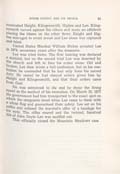
[p. 51]
municated
Haight, Klingensmith, Higbee and Lee. Klingensmith turned against the others and made an affidavit placing the blame on the other three. Haight and Higbee managed to avoid arrest and Lee alone was captured and tried.
United States Marshal William Stokes arrested Lee in 1874, seventeen years after the massacre.
Lee was tried twice. The first hearing was declared a mistrial, but on the second trial Lee was deserted by the church and left to face his crime alone. Old and broken, Lee then wrote a full confession, but in his confession he contended that he had only done his sacred duty. He stated he had obeyed orders given him by Haight and Klingensmith, and that their orders came from God.
He was sentenced to die and he chose the firing squad as the method of his execution. On March 23, 1877 the government had him transported to the exact spot on which the emigrants stood when Lee came to them with a white flag and guaranteed their safety. Lee sat on his coffin and refused the marshal's offer of a bandage for his eyes. The rifles roared and the twisted, fanatical life of John Doyle Lee was snuffed out.
This officially closed the Mountain Meadows case.
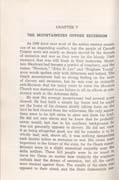
[p. 52]
CHAPTER V
THE MOUNTAINEERS OPPOSE SECESSION
As 1860 drew near most of the nation seemed conscious of an impending conflict, but the people of Carroll County were not nearly so deeply moved by the threats of secession and war as they were by the bloody Utah massacre that was still fresh in their memories. Mountain Meadows had become a symbol of treachery, and the names "Mormon," "John D. Lee" and "Brigham Young were words spoken only with bitterness and hatred. The Ozark mountaineer had no strong feeling on the issue of slavery and secession, but he was now so violently anti-Mormon that for many years to come the Mormon Church was destined to see failure in all its efforts at missionary work in the Arkansas hills.